Battle Cruiser: Fon der Tann vs Indefatigeble. H.2
Thus, the UK took a brilliant start, but, alas, could not keep up the pace. Lord Caudor, who transferred to 1905 the powers of the First Sea Lord, D. Fisher, wrote about the necessity of laying four ships a year, then, if the construction of a heavy warship was two years, eight such ships would be built at any given time in England. Alas, D. Fisher managed to sustain these rates only in the 1905-1906 program, when the Dreadnought and three Invinsibles were laid, and then (although not without heated debate), the government decided that three ships would be enough. As a result, in 1906-1907 and 1907-1908. Three battleships of the Bellerophon and St. Vincent types were laid, respectively, but the battle cruisers were not laid at all.
This, of course, did not mean that all work on the battlecruisers was abandoned. The British continued to design ships of this class, trying to find the optimal fusion of tactical and technical characteristics.
Perhaps the most innovative proposal was the project ХNNUMX, which, to be honest, had nothing to do with the battle cruisers, but was proposed for construction in the program 4-1906. "On the Rights" of the battleship. In it, the British formulated the concept of the future high-speed battleship - the X1907 should have the same main caliber as the Dreadnought (4-10-mm / 305 guns), 45-mm armor, barbety and towers and the speed of the battle cruiser, that is, 279 knots. The idea was brilliant, but it was saved by the economy - even the displacement of such a battleship had to be 25 22 tons, and the government thought it would be an overly expensive ship. As a result, the X500 project went to the archives, and on the stocks there were very, I must say, ordinary Bellerophon type battleships.
But in the next shipbuilding program 1907-1908. the fleet nevertheless hoped to "knock out" the laying of the battle cruiser, and the design of ships of this class resumed. As always in such cases, a whole series of different projects were drawn up. Surprisingly, but the fact is that this time the designers took a firm course on the German concept of the battle cruisers. If the first projects were almost the same "Invincibles" with slightly improved reservations, but reduced speed, then subsequent ones offered armor thickness even 254 mm. The most promising option was the “E” variant, presented by 5 December 1906 g, and if the second series of British battlecruisers was based on this project, then the British would get very interesting ships. Option “E”, like “Invincible”, was armed with eight 305-mm guns, but these were more powerful and heavy fifty-caliber guns. If the Invincible guns fired 386 kg with projectiles with an initial speed of 831 m / s, then the new guns accelerated the same projectile to 869 m / s. However, it should be noted that the new British twelve-inch was not very successful, which is why, in fact, His Majesty’s fleet switched to 343-mm guns. A diagonal layout of the main caliber was assumed, while all eight guns could participate in the onboard salvo, and in general, the E variant looked more powerful than Invincible or Fon der Tann.
At the same time, option “E” was supposed to be protected by a very powerful and extended 229-mm armor belt, moreover, apparently, it was planned to strengthen the booking of other parts of the ship relative to the first series of battle cruisers. The total weight of the armor for option “E” was to be 5 200 t versus 3 460 t in Invincible. At the same time, and in contrast to other projects of the battle cruiser, the project “E” provided for the achievement of 25-nodal speed.
Project E, if embodied in metal, would be a "hard nut to crack" for German battle cruisers. His 229 mm armor very well protected the ship from German 280-mm shells at medium combat distances: recall that the Fon der Tanna guns punched 200 mm armor only on 65 cable, while British 305-mm / 50 guns were more powerful than the Germans. In principle, the “E” project did not look so bad even against the background of the following Germanic battlecruisers, the Moltke and the Geben. But, unfortunately, the British fleet did not receive this ship. The shipbuilding program 1907-1908's. the battlecruisers did not hit at all, nevertheless, the design work for the “E” variant continued, in the hope that someday the UK would still return to the construction of the battlecruisers.
Alas - in June 1907 r the British government proposed to abandon the further construction of cruisers with 305-mm guns (the term “battle cruiser” did not exist then, and the Invincibles were considered armored) and in the future lay two cruisers with 234-mm artillery. Against this background, the “promotion” of variant “E”, whose displacement in the initial draft was 21 400 t, but by June 1907 g had grown to 22 000 t, it would be extremely difficult - being built by St. Vincent and planned to build “Neptune” had less than 20 000 t normal displacement. Justifying the government that the country needs a cruiser, which is larger than a battleship, would be an extremely trivial task in such conditions.
Nevertheless, perhaps, the sailors would have succeeded if it had not been for the views of the First Sea Lord D. Fisher. He sincerely believed that the battlecruiser was more than six inches of armor and one inch of armored deck, and did not see any reason at all to protect ships of this class better than the Invincible. As a result, the views of the First Sea Lord and the government coincided to a certain extent, which predetermined a compromise - the battle cruiser Indefatigeble. What kind of ship did the British have?
Consider the weight report "Indefatigeble" (in parentheses - the corresponding indicator of the battlecruiser "Invincible"):
Equipment - 750 (680) t;
Artillery - 2 440 (2 580) t;
Machines and mechanisms - 3 300 (3 655) t;
Normal fuel capacity - 1 000 (1 000) t;
Armor - 3 460 (3 735) t;
Enclosure - 6 200 (7 000) t;
Displacement stock - 100 (100) t;
Total normal displacement - 17 250 (18 750) t.
In other words, the hull was almost 13% heavy, the machinery and mechanisms were 10,75% heavy, the artillery was 5,73% heavy, and the completely insufficient booking of Invincible was only 8%, i.e. in the weight gain of articles, the armor took the “honorable” penultimate place. In general, the figures indicated irrefutably indicate that the British, in fact, created only slightly edited Invincibles.
Artillery
The British preferred to classify the maximum information about the new project of the battle cruiser. The Naval und Military Record magazine hinted at the 343-mm guns on the Indefatigable and being built with it under the 1908-1909 program. dreadnought "Neptune". Jane argued that the new battlecruiser was protected by a 203 mm belt on the waterline, the 76 mm deck and the armor of its towers reached 254 mm, but with all this, the cruiser was developing 29-30 nodes. Oddly enough, but the fog that enveloped the true performance characteristics of the cruiser did not disappear to the end in our time.
A number of authors, including very reputable ones, such as O. Parks, for example, argue that the second series of British battlecruisers received the newest British 305-mm / 50 gun, which, by the way, also armed itself while being built simultaneously with Indefatigeble "Neptune". Other sources (D. Roberts) write that the ships were armed with old 305-mm / 45 guns, exactly the same as those installed on Invincible. And here, for example, dear VB Mujenikov reports, referring to “official drawings and other primary sources”, that 305-mm / 45 guns were only on Indefatigeble, and the subsequent New Zealand and Australia received 305-mm / 50 artillery. The author of this article does not undertake to put the final point above the “i” in this question, but is inclined to the version of VB Muzhenka. Mine bombardment - 16 102-mm guns - did not differ from that on the Invincible, but their placement changed somewhat. The guns were no longer placed on the roofs of the towers, but completely placed in the superstructures: six in the bow and ten in the stern.
As for the torpedo tubes, their number was reduced from five to three, or even to two - sources also did not agree on this.
Reservation
When reading numerous publications on the Indefatigeble battle cruiser, it seems that the protection of this ship remained at the level of its predecessors, the Invincibles. However, this is absolutely not the case: oddly enough, but in the new project the British managed to worsen the already weak protection of the Invincible battlecruisers. But first things first.
As we have said before, the Invincible artillery was located in a diagonal pattern, but the “traverse” (onboard) towers were too close to each other, which prevented their simultaneous firing at one side. Accordingly, in the project "Indefatigigebla" these towers smashed closer to the ends, so that the second series of British battle cruisers could fight with all eight guns at the same time. However, this arrangement led to the need to move the bow and stern towers closer to the ends.
Translated into figures, the Indefatigeble hull has become 7 meters longer than Invincible has been. But at the same time, the “Indefatigebla” bow tower was located not in 42 m from the stem, but only in 36, at the same time the stern defended from the stern section not on 38,4 m, but only on 31,3 m. Accordingly, the distance between the bow and stern axes towers increased by 20,1 m (for VB Muzhenikov, for some reason, 21 m is indicated).
But increasing the distance between the bow and stern towers required an increase in the length of the citadel. In other words, in order to provide the same protection that Invincible had, the 152-mm armor belt had to become a meter longer on the 20,1 meter in the Indefatigable project! However, such an increase required an increase in the mass of armor, and there was no displacement reserve for this.
And here's the result - if the Invincibles had their 152 mm belt protected not only the boiler rooms and engine rooms, but also the feed pipes and cellars of the main caliber bow and stern turrets (though there were not enough Invingibles in the stern tower, but it was defended by traverses, located at an angle to the board), then on the “Indefatigeble” “six-inch” protection was provided only by the boiler rooms and machine rooms. The boards in the area of the main-head bow turret were defended with only 127 mm of armor, while the stern - 102-127 of mm! The length of the 152 mm armored belts of the first and second generation of British battlecruisers is perfectly illustrated by the schemes below.
Here is the “Indefatigebla” booking scheme
And here, for comparison, "Invincible", top view
In other words, it turned out like this. Without a doubt, the 152 mm armor belt was insufficient even against the 280 mm German shells with the armor penetration 200 mm armor Krupp on the 65 cable. But still, under certain conditions (if the ship does not go perpendicular to the trajectory of the projectile flying into it) and good luck, as well as taking into account the 50 mm bevel behind the armor belt, he could sometimes prevent enemy shells from penetrating into the artillery cellars, machine rooms and boiler rooms. But 102-127 mm “armored protection” of the bow and stern towers “Indefatigebla” would break through the 280-mm projectile in almost all reasonable positions.
The British, apparently, still understood what they were doing, so they tried to somehow compensate for the weakening of the on-board booking by increasing the barbet's defense. At the Invincible stern tower, for 152 mm, armor barbet had 50,8 mm of armor, in Indefatigeble, for 127 mm armor - 76,2 mm, and for 102 mm armor - 102 mm. Formally, it seems that the defense did not suffer - the same 203 mm aggregate armor. But the problem was that the traverse of Invincible covered the barbet at such an angle that the enemy projectile, which fell perpendicular to the slab, passed the barbet's “casual”, having good chances of rebounding, and vice versa - in order to strike at an angle, close to 90, to the barbet, it was necessary to pierce the 152 mm armor plate at a large angle. Thus, despite the formal equality of the thicknesses, the barbet of the aft tower “Indefatigebla” was still less well protected than the “Invincible”. Well, below barbet (which lasted only until the armor deck), the ammunition cellars of the Indefatigebla were defended by 50 mm bevel and 101-127 mm side armor, against 50 mm and 152 mm, respectively, at Invinsible.
With the nose tower, the case of the Indefategebla was even worse. The barbet 178 mm thick lasted only until the armored wall thickness 25 mm, which rested on the upper edge of the 127 mm belt, and below, according to the scheme, had no protection at all. So the enemy shell went inside the barbet during the breakdown of the inch deck, or when overcoming 127 mm of armor board - more barbet did not protect anything. The cellars had all the same 127 mm bead + 50 mm bevel against 152 mm and 50 mm for Invinsible.
“Invincible” at least could take the fight on the acute nasal corners - for example, holding the same “Fon der Tann” on the 45 course angle (how can you not recall the “combat loxodrome” of MK Bakhirev in the battle of Gotland in 1915 d). In this case, the British cruiser, at practically the same angle, would substitute the enemy 152 mm shell and 178 mm bow traverse. And already under 45 hail. 152 mm, and even more so 178 mm armor plates had a good chance to keep the German 280-mm projectiles. "Inflexible" could not do anything - it was only 102 mm traversed in its nose, so turning it to the German ships with its nose (even if at an angle) was categorically contraindicated to it.
The Invincible six-inch armor-belt had a length of 95 m at a height of 3,43 m, in Indefatigebla, because of the need for a longer length of the citadel, the length of 152 mm section was 91 m at a height of 3,36 m
But as for the horizontal protection of the Indefategebla, then with it, alas, there are still ambiguities. Some sources claim that its total thickness within the citadel corresponded to that of Invincible, i.e. 25,4 mm main deck plus 38 mm armor deck in its horizontal part and 50 mm - on the bevel. But others say that the horizontal part of the armor deck was reduced, and was 25,4 mm, i.e. The horizontal defense of Indefatigebla was weaker.
Regardless of which of them is right, we have to state that the only advantage of the “Indefatigebla” project - the diagonal arrangement of the towers in such a way that all 305-mm guns could be fired on one side was bought at an extremely expensive price, namely, critical weakening armor protection of feed pipes and cellars of the bow and stern towers of the main caliber.
But here there are interesting nuances. V.B. Muzhenikov claims that the protection described above was only “Indefatigeble”, while the following “New Zealand” and “Australia” received a long 152 mm belt as much as 144,2 m, and in this case, of course, it should be recognized that these two cruisers received better vertical protection than Invincible or Indefatigeble. But it is necessary to take into account that in this case a number of questions arise that the respected historian does not explain at all. The fact is that if “New Zealand” and “Australia” both received the latest 305-mm / 50 tools and longer armor, then how did the British manage to “fit” all these innovations into the displacement, which according to the 50 project tons exceeded that of the "Indefatigigela"?
Even the lightest version of the 305-mm / 50 Mark XI guns weighed 9 144 kg more than the 305-mm / 45 Mark X guns. But apart from the weight of the gun itself, there is also the weight of the machine, which probably was somewhat more, because the recoil The new gun was stronger, the charges to the guns also weighed more, and so on. Accordingly, to accommodate heavier guns and armor on New Zealand it was necessary to remove something, save. What exactly? Perhaps this is how the difference in the reservation of the horizontal part of the Armored Deck (38 mm or 25,4 mm) in different sources is explained, and in Australia and New Zealand the vertical armor was enhanced by the horizontal one?
Power plant
The power rating of the power plant on the Indefateible was 43 000 HP on Indefatigable and 44 000 hp on New Zealand and Australia. This is only on 2 000 - 3 000 hp exceeded the power plant "Invincible", but it was believed that with such power linear cruisers of the type "Indefatigeble" will develop 25 knots.
On tests, all cruisers of this type exceeded the speed expected from them. During the eight-hour run of the “Indefatigeble” with the average power of the 47 135 HP machines. developed an average speed of 27,4 knots., “New Zealand” with 45 894 hp - 26,3 knots., And “Australia” - 26,9 knots. Unfortunately, O. Parks does not indicate the power of the machines in this case. The maximum speed of all three cruisers exceeded 27 knots. The normal design reserve of fuel was 1000 tons of coal, the maximum for Indefatigebla was 3340 tons of coal and 870 tons of oil, for Australia and New Zealand 3170 tons of coal and 840 tons of oil. Daily fuel consumption at 14 speed knots. amounted to 192 tons, respectively, at one angle only the battlecruisers could go 5 550 - 5 850 miles.
construction
Under the program 1908-1909. Britain laid only two large ships - the battleship Neptune and the battle cruiser Indefatigeble.
Both ships were supposed to become non-serial because next year it was supposed to lay ships on other projects. However, such a significant reduction in shipbuilding programs - three ships each in 1906-1907 and 1907-1908. and only two ships in 1908-1909. instead of four previously built, embarrassed the leadership of the British dominions. As a result, Australia and New Zealand financed the construction of two more battlecruisers. This, no doubt, a good undertaking nonetheless led to a completely inadequate solution, because Australia and New Zealand were laid at the time when new battlecruisers with 343-mm artillery were already being built on the stocks.
The construction of the New Zealand cost in 1 684 990 f.st., its tools cost 94 200 f.st., and the total cost of building the ship amounted to 1 779 190 f.st. At the same time, "Princess Royal" was worth the Crown 1 955 922 f. Art., tools for it - 120 300 f. Art. and the total cost was 2 076 222 f. Art.
The difference in the cost of these two ships was only X.NUMX 297 f.st., but by adding the specified amount to the donations of the dominion, His Majesty's fleet would have received a much more powerful ship of the next generation. However, apparently, this opportunity did not occur to anyone.
Comparison with Fon der Tann
The normal von der tanna displacement was 19 370 t, the British battle cruiser - 18 470 t. Rated power of the machines - 42 000 hp in German and 43 000- 44 000 hp the British cruisers predetermined their comparable driving performance. If Indefatigeble was designed for 25-nodal speed, then Von der Tann should have developed 24,8 ties. On tests, both ships developed much greater power and demonstrated, in general, similar speed parameters: the Indefatigable showed 27,4 ties on an eight-hour run, and the Fon der Tann showed 26,8 ties. at six o'clock. True, the German boilers turned out to be somewhat “voracious” of their British “brothers”, and Von der Tann had a slightly shorter range, 4 400 miles on 14 nodes against more than 5,5 thousand miles from British cruisers. But the range for action in the North Sea, in general, is of secondary quality, superiority in this area did not give the British cruisers great advantages. Of course, longer range means more time during which the ship can maintain high speed and greater distance that the ship will pass with broken pipes and fallen down, but, strictly speaking, the superiority of British cruisers in the range of the course rather equalized their capabilities with the German ones. Still, the British cruisers were "beaters" who were supposed to "intercept and punish" the high-speed ships of the Germans, and if so, they needed to "run" (even before the battle) more than the German ones. Thus, we see that D. Fisher’s thesis that “speed is the best defense” did not work against the first German battleship, because the speed was “protected” not worse than its British counterparts
On the whole, it can be stated that the Germans managed to create a much more balanced and harmonious ship than the British in the Indefatigeble project. In this regard, it would be very interesting to make an analysis of the armor penetration capability of the Indefatigebla armor with the Von der Tanna cannons and vice versa, but unfortunately, based on the data available to the author, an accurate analysis is impossible.
Without tiring the respected reader with the nuances of armor penetration calculations using de Marr formulas (considered canonical for such calculations), we note that the data in the broad press is somewhat contradictory. For example, O. Parks indicates that the British 305-mm / 45 cannon Mark X punched 305 mm of armor Krupp at 7 600 m distance. This roughly corresponds to 245 mm armor penetration at 50 KBT., But in other sources 269 armored thickness is indicated mm at the same distance. At the same time, German sources indicate that the Fon der Tanna 280-mm / 45 cannons were able to penetrate 200 mm of Krupp armor on 65 cable, but alas, they do not contain basic data to verify the validity of these figures. de Marr formulas. In addition, it should be borne in mind that Krupp armor produced in different countries is not identical, but, of course, each country uses in the calculations the data of the armor itself. There is an opinion that the English armor of the First World War was stronger than the German one, but the author of this article did not find a reliable justification for this thesis.
If we take the practical results of the clashes, then in the Jutland battle the German guns, in general, confirmed the stated results - for example, the Moltke 280-mm projectile from a distance of 66kb of KBT, approximately, fell into the 229 mm barbet of the Tiger tower cruiser, knocked out a piece of armor the size of 400 * 700 mm and went inside (but did not explode). This is more than the 200 mm specified for Fon der Tanna at a distance of 65 KBT. But it should be noted that the Moltke cannons were somewhat more powerful and dispersed the 302 kg projectile to 880 m / s, i.e. on the 25, the m / s is faster than the guns of the first German battleship. With this amendment, the 200 mm for 280-mm / 45 look quite realistic.
At the same time, at the time of the 3 battle, the squadron of Admiral Hood’s battle cruisers with Lutzov and Derflinger was hit by the English 305-mm projectiles in 300 mm and 260 mm in the Derflinger armored plate (the distance fluctuated 30-50 mm Dernlinger 305-mm armored plates (the distance fluctuated 45-XNUMX mm Dernlinger XNUMX armored plate (the distance fluctuated XNUMX-XNUMX mm Dernlinger XNUMX-mm) however, no case of armor penetration was recorded. Strictly speaking, this doesn’t prove anything, because we don’t know at what angle these outfits fell and whether they were armor-piercing, but in any case, we have no reason to believe that the British XNUMX-mm / XNUMX guns had better armor than the one that indicates O. Parks and which follows from the calculations for de Marr.
Recall now the booking of the German and British cruisers.
It should be noted that in most cases the 152 mm armor of the Invincibles and the Indefatigeble is opposed by the 250 mm of the Von der Tanna armored belt, but this is still not entirely correct, because the 250 mm of the German Cruiser was very narrow - the height The 250 mm of the armored belt did not exceed 1,22 m (according to Muzhenikov) or, perhaps, the 1,57 m, while the height of the Armored belt “Indefatigebla” was 3,36 m. Yet the main board booking (and barbets of the towers of the main caliber) consisted of 203 mm armor plates against 152-178 mm from the British.
But in this case too, the “Indefatigeble” loses to “Von der Tanna” with a truly crushing score. The walls and barbettes of the British battlecruiser are quite comfortable making their way with the Fon der Tanna cannon at a distance of 65-70 KBT., While the English battle cruiser has approximately the same level of “comfortable armor penetration” by no more than 50 KBT. We are talking here about "comfort" in the argument that armor penetration is usually indicated by armor plate installed perpendicular to the earth's surface and if it were not for the angle of incidence of the projectile, then it would fall into it at an angle of 90 degrees. At the same time, in combat, there is pitching, ships are usually deployed at an angle to each other, etc., that is, the projectile usually hits armor at a greater angle than is provided for armor penetration tables.
So - the “Fon der Tann” is quite capable of punching the sides and barbets of the English battle cruiser on the 65-70 kb, while the artillery of the Indefatigebla has similar capabilities with respect to the German ship somewhere on the 50-55 kb. But on the 50-55 kbt cannon, the “Fon-der-Tanna” can confidently pierce not only the 152 mm board, but also the 50 mm bevel and the 64 mm protection of the cellars of British ships, while the British guns - only 200 mm board, despite the fact that to go into the car or cellar (250 mm board plus 50 mm bevel) there are no chances for British shells. And again - we are talking about 152 mm armor of British ships, but the cellars of the bow and stern towers of the Inflexible were covered only with 102-127 mm of armor ...
But why did the Germans, with a generally insignificant difference in displacement, get a much stronger ship? The answer, apparently, should be sought in the weight report "Fon der Tanna" and "Indefatigebla." It should be noted here that it is impossible to compare figures from reference books directly, because the same articles of weights for the British and the Germans had a different content. For example, according to the article “artillery”, the Germans indicated the weight of the towers without armor, the British - with armor, but the weight of the armored decks, which the British counted in armor, the Germans considered part of the hull and indicated it in the mass of hull structures.
With the appropriate adjustments, the mass of the Fon der Tanna armor was 5 693 t, while the mass of the Indefatigeble armor was only 3 735 t, in other words, the Germans managed to find an opportunity to install more armor on the 1 958 t than the British. How? Here one could recall the lighter weapons of the Von der Tanna, but alas - it is quite comparable with the British and is 2 604 t against 2 580 t. That is, the German battle cruiser carried more tons of weapons on the 24 than the “Infinite” "! The thing is that, of course, the English guns were harder, but the Germans better armored the towers of the main caliber, and therefore some parity arose. But the British power plant had a mass of 3 655 t, while the German one had only 3 034 t., That is, with almost equal nominal power, British cars and boilers turned out to be heavier on 620 t. And almost a thousand tons turned out to be heavier than the hull of a British ship - that is, with large sizes, the hull of the German battle cruiser weighed significantly less than the English!
In principle, one could try to explain such an economy of hull structures either by insufficient hull strength or too low of its height, which predetermines unimportant seaworthiness. But in the case of Von der Tann, these explanations do not work too well, because claims to the strength of its hull never sounded, and as far as the height of the board, here you can push away from such an important indicator as the height of the axes of the main caliber guns above sea level. In Indefatigebla, the indicated index for the bow turret was 9,7 m, the “traverse” turret - 8,5 m, and the stern turret - 6,4 m. The height of the axes of the guns in the “Fon der Tanna” was 9,9 m for the nose turret and 7,7 m for the rest, that is, it was quite comparable with English.
Probably, the naval cruisers of the Invincible and Indefatigeble type still outperformed the Von der Tann, but this superiority was clearly not so great as to sacrifice at least a thousand tons of armor for it.
The author of this article considers the Invincible-type battlecruisers to be a mistake of British shipbuilding. But this error is to some extent excused by the fact that the British were still innovators and created ships of the new class. The construction of Indefatigeble, New Zealand and Australia has no such excuse. There is no doubt that a significant part of the blame for them lies with the British government, who decided to save where it was completely inappropriate, but the fault of the First Sea Lord in this case is no less.
At the same time, having stumbled on the first step (the big cruiser “Blucher”), the Germans created, not afraid of this word, the magnificent “Von der Tann”. Without a doubt, both the British, and the German dreadnoughts, and the battle cruisers of the first series had various, sometimes serious enough flaws. Von der Tann was not deprived of them either, but in terms of its characteristics it was much more responsive than Dreadnought or Nassau, Invincible, or Blucher. From this point of view, among the “big ships” of the first “dreadnoughts” series “Fon der Tann”, in the opinion of the author of this cycle, he approached the ideal of a heavy warship as close as possible. No doubt, already a few years after his laying, both in England and in Germany began the construction of much more powerful and sophisticated ships, but there is no reproach to the creators of the first German battle cruiser. Progress in those years was moving by leaps and bounds. And for its time, the Von der Tann became the benchmark of the battle cruiser - the ship turned out to be so good that the German shipbuilders themselves managed to repeat its success not immediately ....
But it is already completely different. story.
Продолжение следует ...
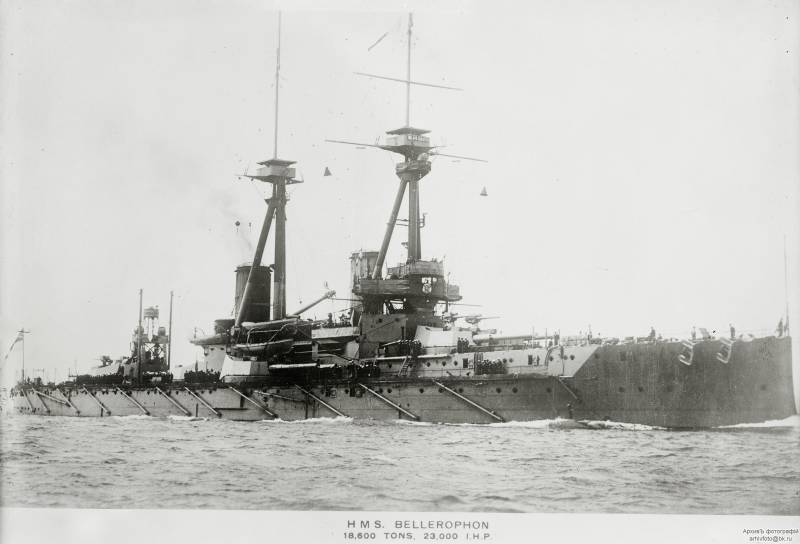
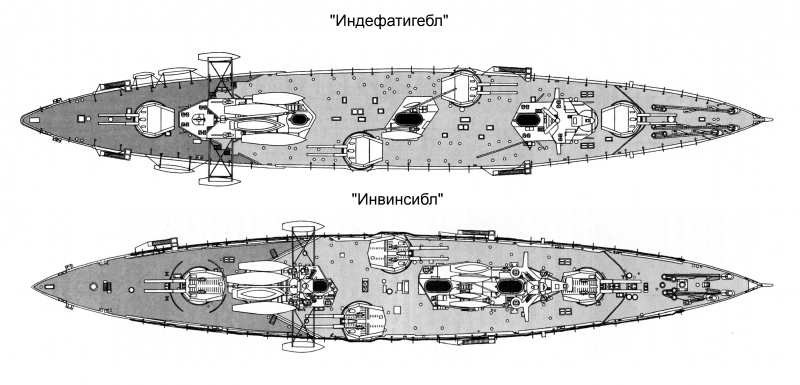
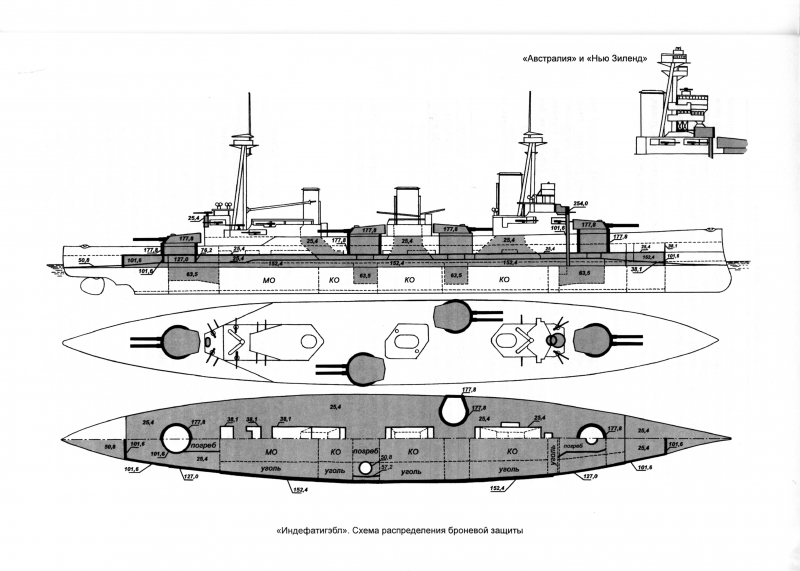

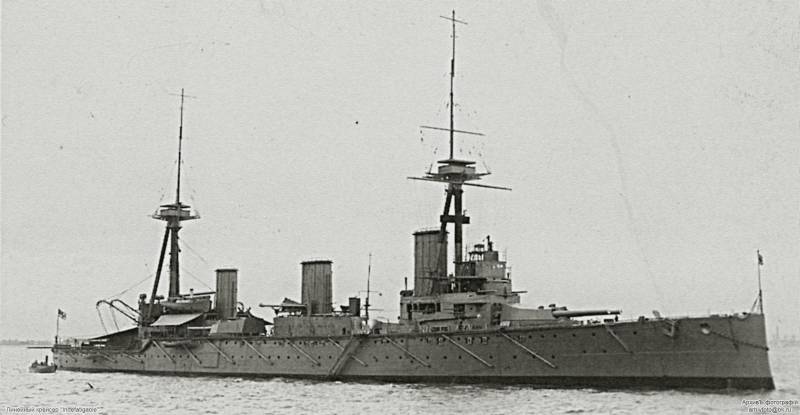
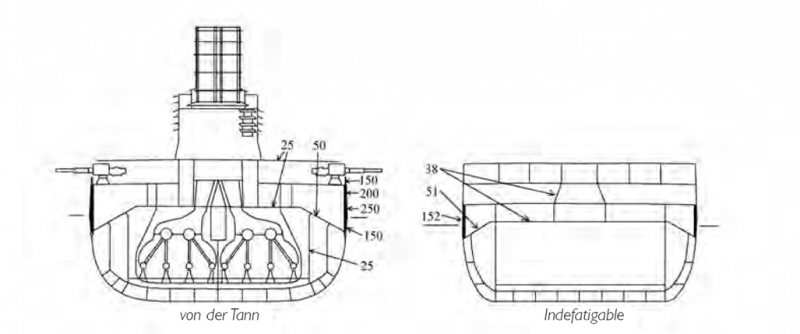
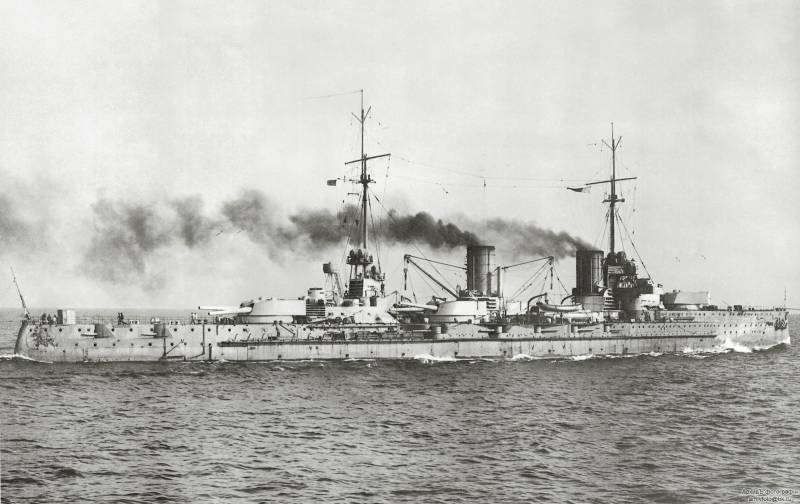
Information